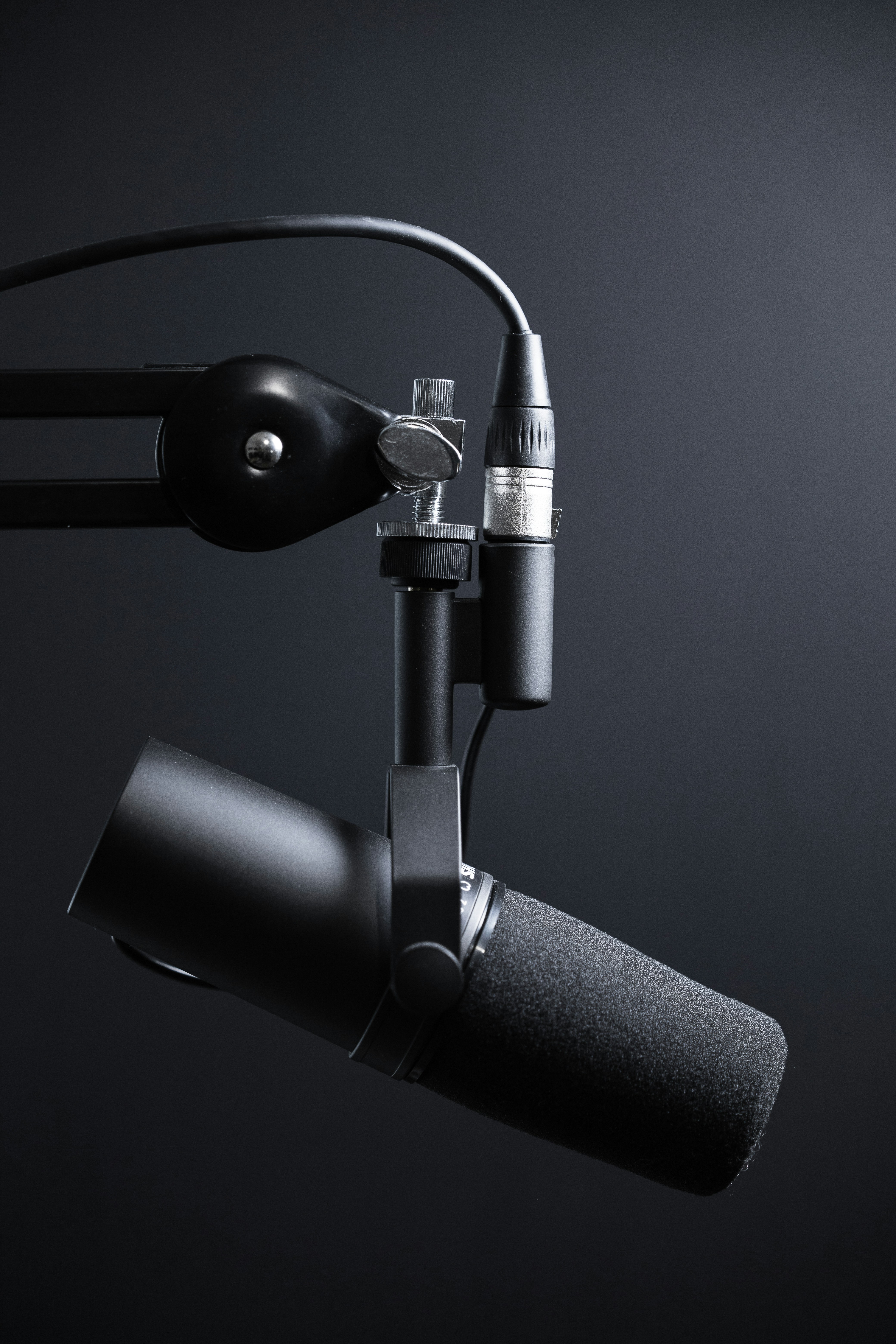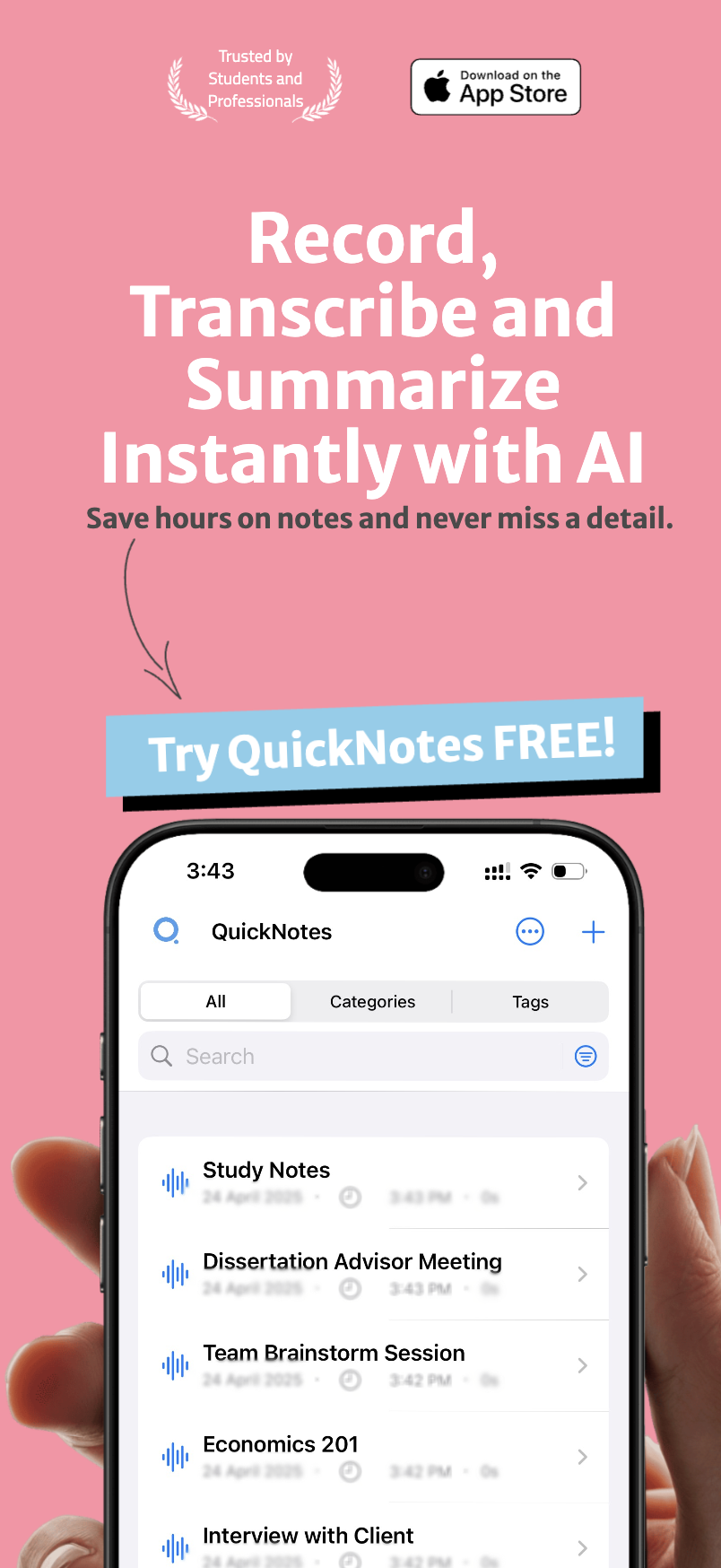The quality of your audio recordings directly impacts the accuracy of transcriptions and summaries in QuickNotes. While our advanced speech recognition technology works remarkably well even with imperfect audio, optimizing your recording quality can significantly enhance results, especially in challenging environments.
Table of Contents
- The Relationship Between Audio Quality and Transcription Accuracy
- Essential Equipment Considerations
- Smartphone Microphones
- External Microphones
- Headset Options
- Environmental Optimization Techniques
- Indoor Environments
- Outdoor Recordings
- Conference and Meeting Rooms
- QuickNotes-Specific Recording Features
- 1. Multi-format Recording Support
- 2. Adaptive Gain Control
- 3. Noise Reduction Processing
- 4. Focus Mode
- Lectures and Presentations
- Interviews
- Personal Voice Notes
- Group Discussions
- Post-Recording Enhancement Techniques
- Audio Enhancement Tools
- Transcription Optimization
- Troubleshooting Common Recording Issues
- Issue: Excessive Background Noise
- Issue: Distorted or Clipped Audio
- Issue: Echo or Reverb
- Issue: Inconsistent Volume Levels
- Conclusion: The Path to Perfect Transcriptions
- You Might Also Like
In this comprehensive guide, we'll explore practical techniques to capture the clearest possible recordings in various situations, ensuring you get the most accurate transcriptions and the most valuable summaries from QuickNotes.
The Relationship Between Audio Quality and Transcription Accuracy#
Before diving into specific optimization techniques, it's important to understand how audio quality affects transcription accuracy:
- Speech Clarity: Clear, well-articulated speech provides more phonetic information for accurate recognition
- Signal-to-Noise Ratio: The prominence of speech relative to background noise significantly impacts transcription quality
- Audio Resolution: Higher-quality recordings capture more nuanced speech sounds that aid in accurate word recognition
- Speaker Consistency: Steady volume and consistent distance from the microphone improve recognition accuracy
While QuickNotes employs advanced noise reduction and audio enhancement technologies, starting with the best possible recording makes a substantial difference in the final results.
Essential Equipment Considerations#
The device you use for recording significantly impacts audio quality. Here's what to know about different recording setups:
Smartphone Microphones#
- Modern smartphones have surprisingly capable microphones
- Position your phone within 1-2 feet of the speaker when possible
- Remove phone cases that might cover microphone openings
- Use airplane mode to prevent interference (unless you need cellular connectivity)
External Microphones#
- A simple lapel/lavalier microphone can dramatically improve recording quality
- USB microphones provide excellent quality for desktop recording scenarios
- Directional microphones help in noisy environments by focusing on the speaker
- Bluetooth microphones offer convenience but may introduce slight quality reduction
Headset Options#
- Many headsets include quality microphones positioned close to the mouth
- Noise-canceling headsets actively reduce background interference
- Wired headsets generally provide more consistent audio quality than wireless ones
- Even basic earbuds with built-in microphones can improve quality compared to recording at a distance
"After switching to a simple lapel microphone with my phone, my transcription accuracy in QuickNotes improved from about 85% to nearly 98%, even in moderately noisy environments." — Sarah K., Journalism Student
Environmental Optimization Techniques#
Your recording environment plays a crucial role in audio quality. Here's how to optimize different settings:
Indoor Environments#
- Choose rooms with carpet, curtains, or soft furnishings that absorb echo
- Close windows to minimize outside noise intrusion
- Turn off noisy appliances like fans, air conditioners, or refrigerators if possible
- Position yourself away from air vents or other sources of consistent background noise
- Consider using a simple sound baffle (even a pillow behind your recording device can help)
Outdoor Recordings#
- Use a windscreen or foam cover over your microphone to reduce wind noise
- Position yourself with your back to the wind when possible
- Choose quieter locations away from traffic, construction, or crowds
- Early morning often provides the quietest outdoor recording conditions
- Create a physical shield around your device using your body or a makeshift barrier
Conference and Meeting Rooms#
- Place your recording device near the center of the table for group discussions
- Consider using QuickNotes' multi-directional recording mode for group settings
- Ask participants to speak one at a time when possible
- Minimize paper shuffling, typing, or other table noises near the device
- For important meetings, consider multiple recording devices positioned strategically
QuickNotes-Specific Recording Features#
QuickNotes includes several built-in features designed to optimize recording quality:
1. Multi-format Recording Support#
QuickNotes offers different recording formats optimized for various scenarios:
- High-Quality Mode: Ideal for important recordings where maximum accuracy is essential
- Standard Mode: Balanced quality and file size for everyday recordings
- Compressed Mode: Space-efficient for very long recordings where storage might be a concern
2. Adaptive Gain Control#
This feature automatically adjusts recording levels to optimize for the speaker's volume:
- Prevents distortion from loud sounds
- Boosts quiet voices for better recognition
- Maintains consistent audio levels throughout longer recordings
- Can be toggled on/off depending on your recording environment
3. Noise Reduction Processing#
QuickNotes' advanced noise reduction can be adjusted based on your environment:
- Light: For already quiet environments with minimal background noise
- Moderate: Balanced setting for typical indoor environments
- Aggressive: For challenging, noisy environments (though this may affect some speech nuances)
4. Focus Mode#
This directional recording feature emphasizes sound coming from a specific direction:
- Ideal for recording a single speaker in noisy environments
- Can be adjusted to focus narrowly or more broadly
- Works best on devices with multiple microphones
Different recording situations require different approaches. Here are optimized strategies for common scenarios:
Lectures and Presentations#
- Sit as close to the speaker as reasonably possible
- Use a directional microphone pointed toward the presenter
- If permitted, place your device on the podium or nearby table
- Select High-Quality recording mode for maximum clarity
- Consider using QuickNotes' background processing to reduce audience noise
Interviews#
- Position the microphone equidistant between participants if possible
- Use a table stand to minimize handling noise
- Choose a quiet location with minimal background noise
- Consider lapel microphones for both interviewer and subject in professional settings
- Test audio levels before beginning the full interview
Personal Voice Notes#
- Hold the device 6-8 inches from your mouth for optimal clarity
- Speak clearly and at a moderate pace
- Standard recording quality is usually sufficient for self-dictation
- Use QuickNotes' pause feature rather than stopping and starting new recordings
- Consider a headset for hands-free dictation while walking or driving
Group Discussions#
- Place the device centrally where it can capture all participants
- Consider QuickNotes' 360° recording mode on supported devices
- Establish ground rules about speaking one at a time if possible
- For larger groups, multiple recording devices synced to the same QuickNotes account can be merged later
- Identify speakers by name periodically to help with attribution in transcripts
Post-Recording Enhancement Techniques#
Even after recording, QuickNotes offers several ways to improve transcription quality:
Audio Enhancement Tools#
- Use QuickNotes' built-in audio cleanup features for existing recordings
- Apply adaptive noise reduction to recordings made in noisy environments
- Normalize volume levels for recordings with inconsistent speaker volume
- Remove specific frequency ranges that contain persistent background noise
Transcription Optimization#
- Select the appropriate language and dialect settings for your recording
- Add custom vocabulary for specialized terminology in your field
- Use the speaker identification feature for multi-person recordings
- Review and correct key terms in the transcript to improve future recognition
Troubleshooting Common Recording Issues#
Even with the best preparation, recording problems can occur. Here's how to address common issues:
Issue: Excessive Background Noise#
Solutions:
- Apply QuickNotes' post-processing noise reduction
- Use the frequency filter to target specific noise frequencies
- For future recordings, use a directional microphone or move to a quieter location
Issue: Distorted or Clipped Audio#
Solutions:
- Enable automatic gain control for future recordings
- Position the microphone further from very loud speakers
- Use QuickNotes' audio restoration tools to attempt recovery
Issue: Echo or Reverb#
Solutions:
- Apply QuickNotes' de-reverb filter
- For future recordings, choose rooms with more sound-absorbing materials
- Record closer to the microphone to improve direct-to-reflected sound ratio
Issue: Inconsistent Volume Levels#
Solutions:
- Use QuickNotes' volume normalization feature
- Apply compression to even out volume differences
- For future recordings, maintain consistent distance from the microphone
Conclusion: The Path to Perfect Transcriptions#
While QuickNotes' advanced AI can produce impressive results even from challenging audio, investing a little effort in optimizing your recording quality pays significant dividends in transcription accuracy and summary quality.
By applying the techniques outlined in this guide—selecting appropriate equipment, optimizing your environment, utilizing QuickNotes' built-in features, and applying post-recording enhancements—you can dramatically improve your transcription results.
Remember that the goal isn't necessarily studio-quality audio, but rather capturing clear, intelligible speech that provides sufficient information for accurate transcription. Even small improvements in your recording setup and technique can lead to significantly better results.
With practice, you'll develop an intuitive sense for optimizing recordings in different environments, ensuring that QuickNotes can transform your spoken content into accurate, useful written material regardless of where you're recording.
You Might Also Like#

AI-Powered Summarization: Extract Key Insights Instantly
Learn how QuickNotes' AI summarization technology helps you extract key insights from lengthy recordings and transcriptions, saving time and improving information retention.

Organization and Tagging: A System for Effective Information Management
Learn how QuickNotes' powerful organization and tagging system helps you categorize, find, and utilize your notes and recordings effectively.

Multi-Language Transcription: Breaking Down Communication Barriers
Discover how QuickNotes' multi-language transcription capabilities can break down communication barriers and streamline global collaboration.

